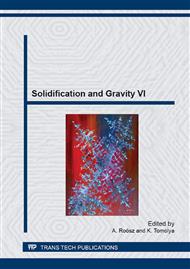p.441
p.447
p.452
p.458
p.464
p.473
p.479
p.485
p.491
Analysis of the Antimony and Strontium Cross-Effects in Al-Si Foundry Alloys
Abstract:
In this work we show the effect of various concentrations of strontium and antimony on the level of modification in the Al-Si alloy. The scale of the modification rate was determined in two ways: thermal analysis was performed and the images of the samples. The eutectic temperature registered during the analysis were compared to the eutectic temperature of the unmodified alloy and on the basis of them was determined which samples are registered as modified, which are not. On the basis of the results of the cooling curves the partially modified category was introduced, if the ΔT value is less than 9°C and more than 7.5°C. The samples made of the alloys were examined with a computer image analysis and the samples were grouped on the basis of the size of the eutectic silicon phases. The aim of our research work was the examination of cross-effects of strontium and antimony.
Info:
Periodical:
Pages:
464-469
Citation:
Online since:
May 2014
Authors:
Keywords:
Price:
Сopyright:
© 2014 Trans Tech Publications Ltd. All Rights Reserved
Share:
Citation:


